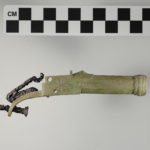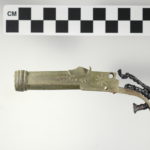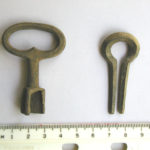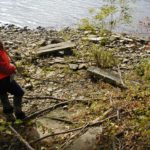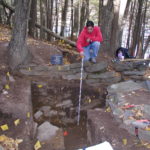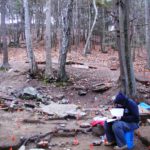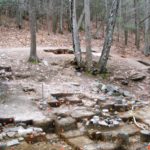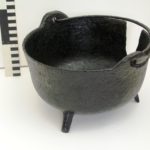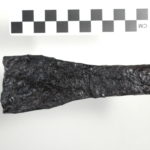Venture Smith Site
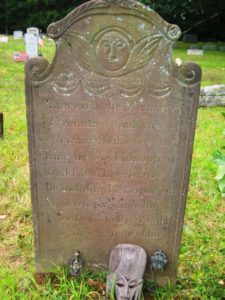
The Venture Smith site is a 17th century homestead and farm located just above the Salmon River on Haddam Neck. Archaeological and ethnohistoric investigations of this site have unearthed the incredible story of its owner, Venture Smith. Venture was born in Africa in 1729 and given the name “Broteer” by his father. At six years old, he was taken to the New World to be sold into slavery. Upon arrival, a man named Robert Mumford purchased hum and he was given the name “Venture.” Mumford took Venture to Rhode Island where he endured 30 years of enslavement. During this time, he faced long hours of arduous work and many tribulations. Despite these circumstances, his work ethic, loyalty, and palpable stoicism allowed him to overcome adversity and win the respect of many—even his owners. After completing his daily duties, Venture was able to work various jobs for pay. By the time he was 36, Venture was able to purchase his own freedom, and a decade later his family’s. He acquired a small tract of land in Connecticut and quickly became a successful farmer and entrepreneur. At the time of his death, Venture owned three houses, a fleet of riverboats, and a 130-acre farm. Fortunately, with the help of a local school teacher, Venture documented his life’s story in his autobiography titled A Narrative of the Life and Adventures of Venture, a Native of Africa: But Resident above Sixty Years in the United States of America. The archaeological investigation conducted by American Cultural Specialists, LLC under the direction of Dr. Lucianne Lavin and Dr. Marc Banks provided details of Venture’s life that were not included in his autobiography in order to form a more complete narrative.
The Venture Smith site investigation uncovered detailed information about the daily life of Venture and his family such as the physical layout of their home, their personal possessions, as well as their eating and drinking habits. The discovery of over 49,000 artifacts, ecofacts, and cultural features also revealed much about Venture’s work ethic, values, cultural identity, and interpersonal relationships.
The Venture Smith site excavation is a prime example of how archaeological evidence can be used to support and enhance primary historical accounts. For instance, in his narrative, Venture attests to his own frugality; “I brought nothing which I did not absolutely want.” Based on archaeological findings, it is clear that Venture spent little money on what he considered ‘frivolous’ items; there was no evidence of games, gaming, liquor bottles, jewelry, or pipe smoking equipment. In his narrative, Venture also mentions being robbed and cheated several times in his dealings with whites. The design of his family compound and artifacts recovered therein, such as a padlock and a pistol, reveal the family’s efforts to dissuade and prevent thievery. This degree of caution is unsurprising based on his past experiences.
While much of Venture’s narrative is validated by archaeological data, there are some discoveries that contradict his narrative. For one, Venture’s house was not the small and simple affair as he described. In fact, the house was relatively large, standing at a story and a half. The entire complex encompassed at least nine structures made up of three houses, several warehouses, a blacksmith shop/forge, a dock, and a boat pull-in. The property was also situated advantageously along one of the deepest parts of Salmon river, allowing access to large boats. The dock, boat pull-in, and blacksmith shop/forge highlight just how self-sufficient the compound, and by extension Venture and his family, would have been.
Documentary and archaeological evidence paints Venture as an active and prominent member of the community on Haddam Neck. That being said, based on his narrative, it is apparent that the crux of his cultural identity remained tethered to his African roots. He explicitly refers to himself as “African” and other members of the black community as his “own countrymen.” Other information regarding his social interactions is few and far between, but his economic transactions are well documented. Venture’s ability to forge trade networks and alliances with high status white families in the area discouraged other whites from cheating him in their dealings. This strategic disposition not only allowed him to become economically prosperous, but it also afforded him and his family security.
Venture and his wife are buried in the churchyard of the First Congregational Church in East Haddam. Their graves are situated in close proximity to the church building; a place which signifies social importance. Typically, this was an honor reserved for high status church members, however, there is no surviving evidence proving Venture’s membership. In fact, there is some evidence that points to the contrary. Quartz and Tourmaline crystals recovered from doorway and window areas of Venture’s home suggest that he actively participated in traditional African ritual practices.
Venture Smith’s life is an awe-inspiring depiction of triumph, perseverance, integrity, and strength of will. Today, it is celebrated in East Haddam every September on a day known as Venture Smith Day.
Citations:
Lucianne Lavin and Marc Banks
2007 Final Report. Phase 1 and Phase 2 Archaeological Investigations of the Connecticut Yankee Atomic Power Company Property in Haddam Neck, CT. The 2005-2006 Field Seasons, with a Synopsis of the 2002-2004 Field Seasons and an Overview of the entire 7-year Archaeological Study. Volumes 1-3. Unpublished report prepared for CYAPO, Haddam Neck, CT. On file at the Homer Babbidge Library, Special Collections, University of Connecticut at Storrs.
Lucianne Lavin and Mark Banks. The Venture Smith Homestead. CT Commission on Culture and Tourism, Hartford, CT 2010.
Venture Smith
1798 A Narrative of the Life and adventures of Venture, a Native of Africa: But Resident above Sixty Years in the United States of America. Related by Himself. Printed in New London in 1798. Reprinted A.D. 1835 and Published by a Descendant of Venture. Revised and Republished with Traditions by H.M. Selden, Haddam, Conn, 1896. J.S. Stewart, Printer and Bookbinder, Middletown 1897.
Additional Resources:
- More Exciting Discoveries at the Venture Smith Archaeology Site by Lucianne Lavin
- Venture Smith Homestead Student Resource by Lucianne Lavin and Marc Banks
- ConnecticutHistory.org: Venture Smith, from Slavery to Freedom by John Wood Sweet
- TeachIt Connecticut: Lesson Plan (Grade 8) – Venture Smith: From Slavery to Connecticut Businessman
